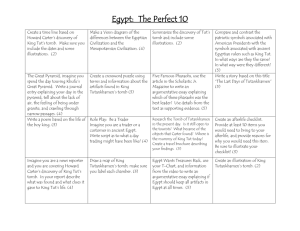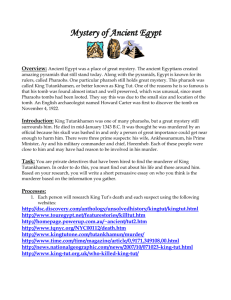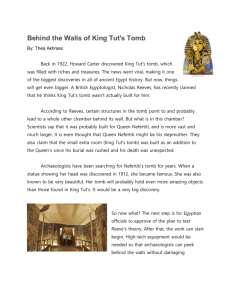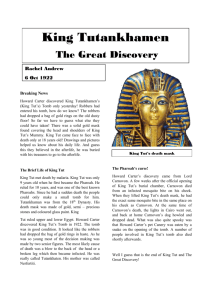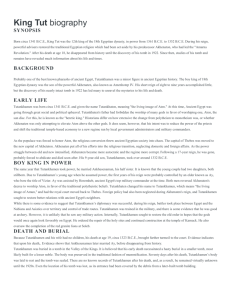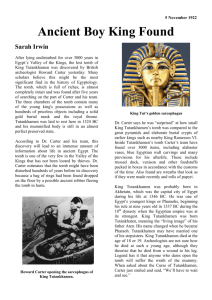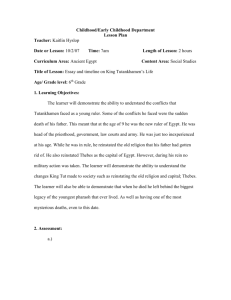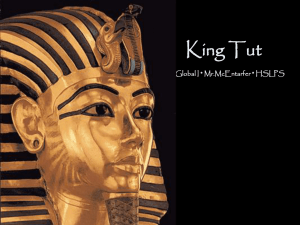King Tut article
advertisement
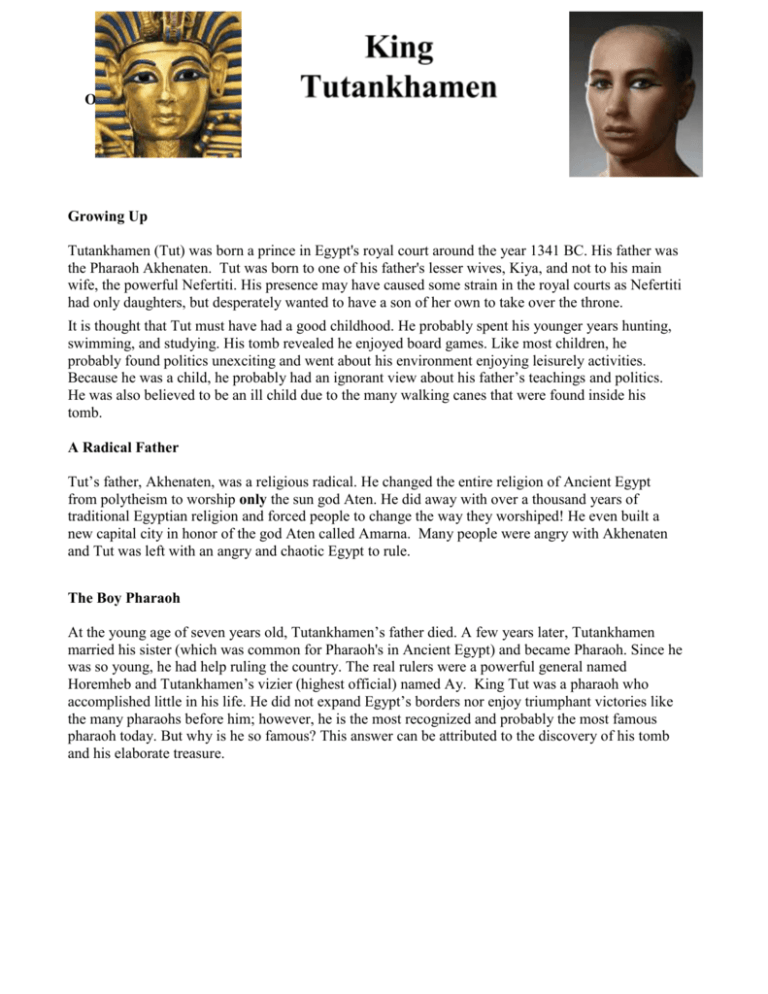
O Growing Up Tutankhamen (Tut) was born a prince in Egypt's royal court around the year 1341 BC. His father was the Pharaoh Akhenaten. Tut was born to one of his father's lesser wives, Kiya, and not to his main wife, the powerful Nefertiti. His presence may have caused some strain in the royal courts as Nefertiti had only daughters, but desperately wanted to have a son of her own to take over the throne. It is thought that Tut must have had a good childhood. He probably spent his younger years hunting, swimming, and studying. His tomb revealed he enjoyed board games. Like most children, he probably found politics unexciting and went about his environment enjoying leisurely activities. Because he was a child, he probably had an ignorant view about his father’s teachings and politics. He was also believed to be an ill child due to the many walking canes that were found inside his tomb. A Radical Father Tut’s father, Akhenaten, was a religious radical. He changed the entire religion of Ancient Egypt from polytheism to worship only the sun god Aten. He did away with over a thousand years of traditional Egyptian religion and forced people to change the way they worshiped! He even built a new capital city in honor of the god Aten called Amarna. Many people were angry with Akhenaten and Tut was left with an angry and chaotic Egypt to rule. The Boy Pharaoh At the young age of seven years old, Tutankhamen’s father died. A few years later, Tutankhamen married his sister (which was common for Pharaoh's in Ancient Egypt) and became Pharaoh. Since he was so young, he had help ruling the country. The real rulers were a powerful general named Horemheb and Tutankhamen’s vizier (highest official) named Ay. King Tut was a pharaoh who accomplished little in his life. He did not expand Egypt’s borders nor enjoy triumphant victories like the many pharaohs before him; however, he is the most recognized and probably the most famous pharaoh today. But why is he so famous? This answer can be attributed to the discovery of his tomb and his elaborate treasure. Ruling Egypt After his father’s death, Tut was given the throne. After acquiring the throne he began to uphold his father’s beliefs, which was the worship of one god -- the Aton. A few years later Tut started to bring back gods that were forbidden by his father, Akhenaten. They soon decided to leave their father’s capital, Amarna, and relocated to a new capital in Memphis and Thebes. This movement was probably suggested by Ay (a high ranking official and advisor) to show the Egyptians and priests that things were slowly returning to the original ways. With the ancient beliefs restored and the movement of the new capital, King Tutankhamen threw lavish parties to show his support for Amun (the king of all Egyptian Gods). Tutankhamen was only a child while the old gods were being reinstated, but could a child make decisions of this magnitude at such a young age? It doesn’t appear so, and it appears that his adviser Ay most likely made major decisions for him. Ay and Hermhab were probably the sole drive behind the throne. Death and Burial Sometime during his tenth year of reigning, Egypt was at war with the Hittites. Tutankhamen died around the age of nineteen. Archeologists aren't sure what killed him. Some people think that he was assassinated, but the likely cause of his death was a wound to his leg. Scientists have determined that the leg of his mummy was broken and badly infected before his death. This injury probably happened from an accident. King Tut had not left a male heir to the throne and the children that he had were stillborn (died at birth). Ay, who was a high official in Akhenaten’s court, staked his claim as pharaoh. Ay went on to rule for only 4 years and died shortly after acquiring the throne. Tomb Tutankhamen is most famous today for his tomb in the Valley of the Kings. It is likely that his tomb was built for someone else and was used to bury the young Pharaoh when he died unexpectedly. This may have helped to keep his tomb hidden from thieves for all these thousands of years. As a result, when archeologist Howard Carter finally discovered the tomb in 1922, it was filled with treasure and artifacts, unlike what’s been found in any other Pharaoh's tomb. King Tut’s tomb was a major discovery of the 19th century. Up until the discovery of King Tut’s tomb, it was believed that all royal tombs had been robbed and drained of their treasure. For the first time, a tomb was left exactly how the ancient Egyptians had left it. The tomb revealed an elaborate lifestyle that many people could only dream about, as well as providing clues and insight into King Tut’s life and how he lived.

